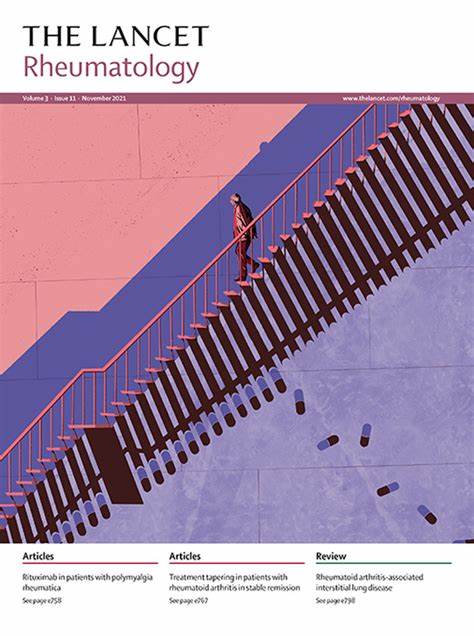Sarilumab治疗复发性多肌痛风湿病:患者报告的3期双盲随机对照试验结果
IF 16.4
1区 医学
Q1 RHEUMATOLOGY
引用次数: 0
摘要
背景:Sarilumab被批准用于对皮质类固醇反应不足或不能耐受皮质类固醇逐渐减少的成年多肌痛风湿病患者。我们的目的是评估sarilumab对患者报告结果的影响。方法:这项三期、双盲、随机对照试验在17个国家的60个中心进行。符合条件的患者为50岁或以上的成年人,在筛查前12周内糖皮质激素减量(剂量≥7.5 mg /天或泼尼松剂量当量)期间至少有一次疾病发作,并且有至少8周的糖皮质激素治疗史(≥10 mg /天或泼尼松剂量当量)。所有患者在筛选前12周内均有风湿多肌痛症状,红细胞沉降率bbb30 mm/h或c反应蛋白浓度至少为10 mg/L。患者被随机分配(1:1)接受皮下sarilumab 200mg,每2周一次,14周糖皮质激素逐渐减少或匹配安慰剂,52周糖皮质激素逐渐减少。患者和调查人员对治疗分配不知情。患者报告的结果测量为健康评估问卷残疾指数(HAQ-DI)、患者整体健康视觉模拟量表(VAS)、疼痛VAS、简短健康调查(sf - 36v2)、EuroQoL 5维3级(EQ-5D,包括描述系统和VAS)和慢性疾病治疗-疲劳功能评估(FACIT-F)。分析患者报告的结果,直到第52周,作为基线的变化。事后分析包括报告至少有最小临床重要差异改善的患者比例和至少达到正常值的评分。P值为标称值。在意向治疗人群中进行分析。在研究的任何阶段都没有让有生活经验的人参与。该试验已在ClinicalTrials.gov注册,编号NCT03600818。研究结果:在2018年10月9日至2020年7月15日期间,118名患者入组并随机分配接受sarilumab (n=60)或安慰剂(n=58)。其中,117名患者接受了治疗(59名在sarilumab组,58名在安慰剂组)。一名被分配到沙伐单抗组的患者没有接受治疗。平均年龄68.9岁(SD 8.1)。118例患者中,女性82例(69%),男性36例(31%),白人98例(83%)。在基线时,sarilumab组59例患者中有43例(73%)报告中度至重度疲劳,安慰剂组58例患者中有43例(74%)报告疲劳。在第52周,沙利单抗组患者在SF-36物理成分总结(PCS;最小二乘平均[LSM]变化7.65 vs 2.87, p= 0.020)和心理成分总结(MCS;3.04 vs - 1.71, p= 0.030)得分,在8个领域中的5个。Sarilumab在EQ-5D效用指数(0.11 vs - 0.02, p= 0.034)和VAS评分(8.37 vs - 0.46, p= 0.084)、FACIT-F评分(7.91 vs 4.17, p= 0.060)、HAQ-DI评分(- 0.39 vs - 0.15, p= 0.054)、Pain VAS评分(- 20.57 vs - 12.04, p= 0.20)和患者总体评估VAS评分(- 15.01 vs - 6.08, p= 0.13)方面均有较大改善。与安慰剂组相比,沙利单抗组更多的患者报告sf - 36pcs评分的最小临床重要差异改善或更高(优势比3.46 [95% CI 1.16 - 10.62], p= 0.020)。在sarilumab组中,超过50%的患者报告SF-36 MCS和4个结构域得分至少达到正常值,而在安慰剂组中,任何结构域都没有出现这种情况。解释:复发性风湿性多肌痛患者的健康相关生活质量受损。使用sarilumab 200mg,每2周1次,14周糖皮质激素逐渐减少,与安慰剂的52周糖皮质激素逐渐减少相比,在健康相关的生活质量和患者报告的结果方面具有临床重要的改善。病情最严重的患者改善程度最高。这些发现为sarilumab用于风湿性多肌痛患者提供了支持,这些患者的疾病活动性和与健康相关的生活质量不能通过糖皮质激素单药治疗根据治疗目标原则得到充分控制。资助:赛诺菲和Regeneron制药公司。本文章由计算机程序翻译,如有差异,请以英文原文为准。
Sarilumab in relapsing polymyalgia rheumatica: patient-reported outcomes from a phase 3, double-blind, randomised controlled trial
Background
Sarilumab is approved for adult patients with polymyalgia rheumatica who have had an inadequate response to corticosteroids or who cannot tolerate corticosteroid taper. We aimed to evaluate the effect of sarilumab on patient-reported outcomes.
Methods
This phase 3, double-blind, randomised controlled trial was done in 60 centres in 17 countries. Eligible patients were adults aged 50 years or older who had at least one episode of disease flare during a glucocorticoid taper (at a dose of ≥7·5 mg per day or prednisone dose equivalent) within 12 weeks before screening and had a history of at least 8 weeks of glucocorticoid treatment (≥10 mg per day or prednisone dose equivalent). All the patients had symptoms of polymyalgia rheumatica and an erythrocyte sedimentation rate >30 mm/h or a C-reactive protein concentration of at least 10 mg/L within 12 weeks before screening. Patients were randomly assigned (1:1) to receive either subcutaneous sarilumab 200 mg once every 2 weeks with a 14-week glucocorticoid taper or matching placebo with a 52-week glucocorticoid taper. Patients and investigators were masked to treatment allocation. The patient-reported outcomes measured were Health Assessment Questionnaire Disability Index (HAQ-DI), Patient Global Assessment of Health Visual Analog Scale (VAS), Pain VAS, Short Form Health Survey (SF-36 v2), EuroQoL 5-Dimensions 3-Levels (EQ-5D including the descriptive system and the VAS), and Functional Assessment of Chronic Illness Therapy-Fatigue (FACIT-F). Patient-reported outcomes were analysed until week 52 as changes from baseline. Post-hoc analyses included proportions of patients reporting improvements of at least minimum clinically important difference and scores of at least normative values. p values were nominal. Analyses were done in the intention-to-treat population. There was no involvement of people with lived experience at any stage of the study. This trial is registered with ClinicalTrials.gov, NCT03600818.
Findings
Between Oct 9, 2018, and July 15, 2020, 118 patients were enrolled and randomly assigned to receive sarilumab (n=60) or placebo (n=58). Of these, 117 patients received treatment (59 in the sarilumab group and 58 in the placebo group). One patient assigned to the sarilumab group did not receive treatment. Mean age was 68·9 years (SD 8·1). 82 (69%) of 118 patients were female and 36 (31%) were male, and 98 (83%) were White. At baseline, moderate-to-severe fatigue was reported by 43 (73%) of 59 patients in the sarilumab group and 43 (74%) of 58 patients in the placebo group. At week 52, patients in the sarilumab group reported greater improvements than patients in the placebo group in SF-36 Physical Component Summary (PCS; least-squares mean [LSM] change 7·65 vs 2·87, p=0·020) and Mental Component Summary (MCS; 3·04 vs –1·71, p=0·030) scores, and in five of eight domains. Sarilumab showed greater improvements in EQ-5D utility index (0·11 vs –0·02, p=0·034) and VAS scores (8·37 vs –0·46, p=0·084), FACIT-F (7·91 vs 4·17, p=0·060), HAQ-DI (–0·39 vs –0·15, p=0·054), Pain VAS (–20·57 vs –12·04, p=0·20), and Patient Global Assessment VAS (–15·01 vs –6·08, p=0·13). More patients in the sarilumab group than in the placebo group reported improvements of minimum clinically important difference or greater in SF-36 PCS scores (odds ratio 3·46 [95% CI 1·16–10·62], p=0·020). More than 50% of patients in the sarilumab group reported scores of at least normative values for SF-36 MCS and four domain scores, whereas this was not the case for any domain in the placebo group.
Interpretation
Patients with relapsing polymyalgia rheumatica have impaired health-related quality of life. The use of sarilumab 200 mg once every 2 weeks with a 14-week glucocorticoid taper led to clinically important improvements in health-related quality of life and patient-reported outcomes versus placebo with a 52-week glucocorticoid taper. Improvements were highest in patients with most severe disease. These findings provide support for the use of sarilumab in patients with polymyalgia rheumatica whose disease activity and health-related quality of life is not adequately managed by glucocorticoid monotherapy according to treat-to-target principles.
Funding
Sanofi and Regeneron Pharmaceuticals.
求助全文
通过发布文献求助,成功后即可免费获取论文全文。
去求助
来源期刊

Lancet Rheumatology
RHEUMATOLOGY-
CiteScore
34.70
自引率
3.10%
发文量
279
期刊介绍:
The Lancet Rheumatology, an independent journal, is dedicated to publishing content relevant to rheumatology specialists worldwide. It focuses on studies that advance clinical practice, challenge existing norms, and advocate for changes in health policy. The journal covers clinical research, particularly clinical trials, expert reviews, and thought-provoking commentary on the diagnosis, classification, management, and prevention of rheumatic diseases, including arthritis, musculoskeletal disorders, connective tissue diseases, and immune system disorders. Additionally, it publishes high-quality translational studies supported by robust clinical data, prioritizing those that identify potential new therapeutic targets, advance precision medicine efforts, or directly contribute to future clinical trials.
With its strong clinical orientation, The Lancet Rheumatology serves as an independent voice for the rheumatology community, advocating strongly for the enhancement of patients' lives affected by rheumatic diseases worldwide.
 求助内容:
求助内容: 应助结果提醒方式:
应助结果提醒方式:


